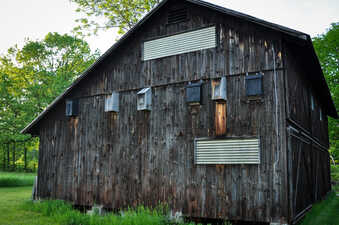Homes for Bats on Halloween
 |
| Bat houses are a great alternative for bats you need to evict from your home, but they do require some maintenance in the late fall or winter to clean out abandoned wasp nests and repair any leaks. |
MONTPELIER, Vt. — The onset of fall sends Vermont's bats into motion, which makes it an important time for conservation-minded Vermonters to learn about, and help conserve, our nine native bat species.
If you have noticed bats roosting in your attic, barn or office over the summer, fall and spring are the perfect times to safely evict these uninvited guests from your property. Bats migrate between winter and summer roosts during the fall and spring and do not have vulnerable young at these times. You can learn how to safely evict bats from your building at the Vermont Fish and Wildlife Department's best management practices
page.
You can also help bat conservation efforts by reporting large colonies of bats living in structures to the department's website. Locations with rare colonies of endangered little brown bats are eligible for free bat houses from Vermont Fish and Wildlife.
Bat houses provide an alternative location for safely evicted bats to remain in your yard and continue eating huge quantities of insects that may be forest, agricultural or human pests. Variety is important, so placing several bat houses with variable solar exposure to help bats find the right temperature ranges throughout the summer helps bats raise their young successfully.
Bat houses can be put up any time of year but do require some simple maintenance. Late fall or winter is the time to look up inside your bat house and make sure all the bats have left before cleaning out any abandoned wasp nests and planning any needed caulking or repainting.
"Fall also means Halloween, and scary images of bats, but this presents an opportunity to bring positive attention to bats as well," said Vermont Fish and Wildlife Small Mammals Biologist Alyssa Bennett. "We celebrate 'Bat Week' in the days leading up to Halloween."
Bat Week takes place Oct. 24-31 and aims to raise awareness about the vital ecological functions of bats and to dispel the many myths and misinformation about them.
Anyone interested in learning more can visit the official Bat Week website at
www.BatWeek.org, or email
Alyssa.Bennett@vermont.gov for more information about what they can do right here in Vermont to promote bat conservation.
Tags: wildlife,

